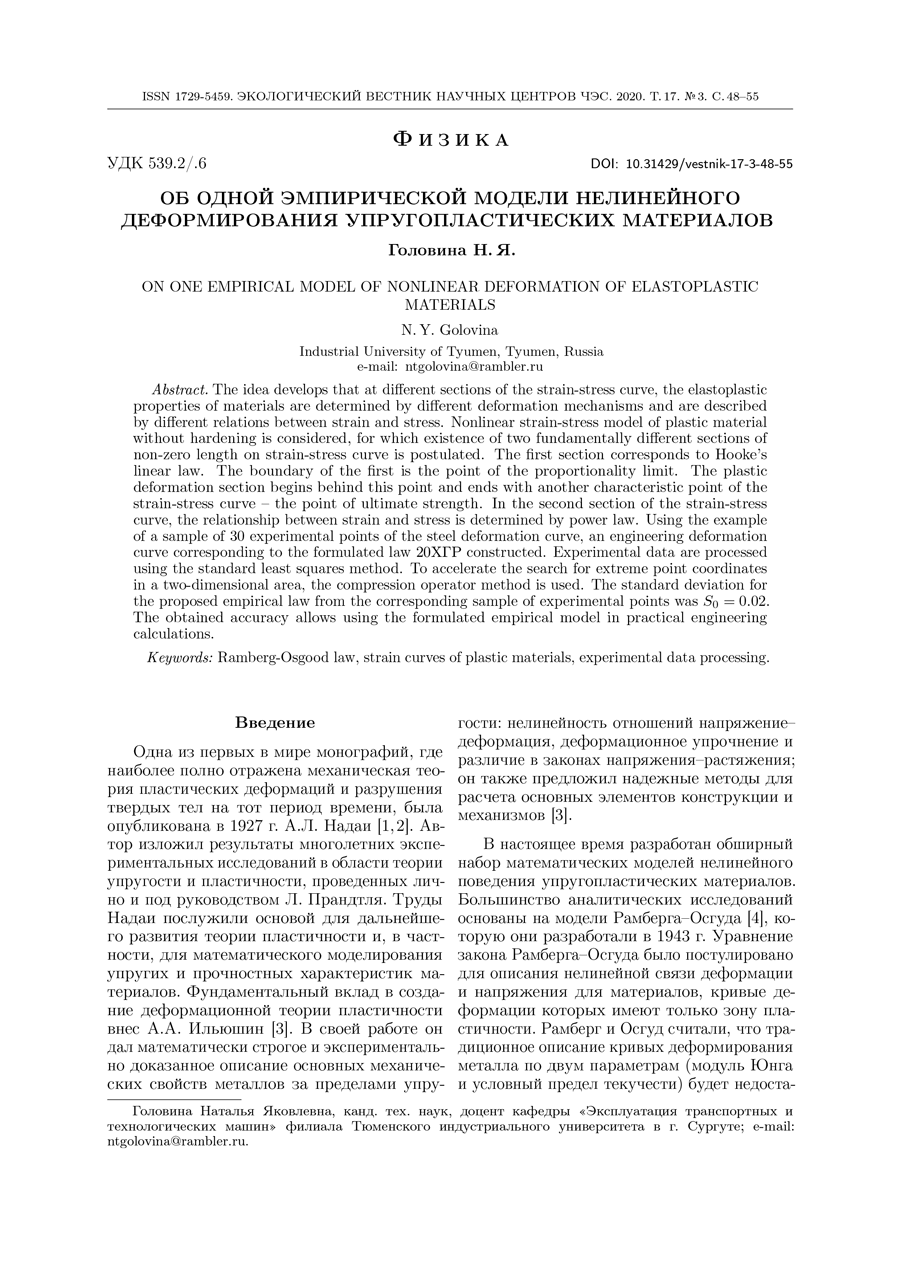On one empirical model of nonlinear deformation of elastoplastic materials
UDC
539.2/.6DOI:
https://doi.org/10.31429/vestnik-17-3-48-55Abstract
The idea develops that at different sections of the strain-stress curve, the elastoplastic properties of materials are determined by different deformation mechanisms and are described by different relations between strain and stress. Nonlinear strain-stress model of plastic material without hardening is considered, for which existence of two fundamentally different sections of non-zero length on strain-stress curve is postulated. The first section corresponds to Hooke's linear law. The boundary of the first is the point of the proportionality limit. The plastic deformation section begins behind this point and ends with another characteristic point of the strain-stress curve - the point of ultimate strength. In the second section of the strain-stress curve, the relationship between strain and stress is determined by power law. Using the example of a sample of 30 experimental points of the steel deformation curve, an engineering deformation curve corresponding to the formulated law 20ХГР constructed. Experimental data are processed using the standard least squares method. To accelerate the search for extreme point coordinates in a two-dimensional area, the compression operator method is used. The standard deviation for the proposed empirical law from the corresponding sample of experimental points was $S_0 = 0.02$. The obtained accuracy allows using the formulated empirical model in practical engineering calculations.
Keywords:
Ramberg-Osgood law, strain curves of plastic materials, experimental data processingReferences
- Nadai, A. Plasticity and destruction of solids. Vol. 1. Izdatel'stvo inostrannoy literatury, Moscow, 1954. (In Russian)
- Nadai, A. Plastic. Mechanics of the plastic state of matter, Vol. 2, Joint Scientific and Technical Publishing House (ONTI) NKTP USSR. Main edition of general technical literature, Moscow, 1936. (In Russian)
- Ilyushin, A.A. Plastic, Leningrad: OGIZ, Moscow, 1948. (In Russian)
- Ramberg W., Osgood, W.R. Description of stress–strain curves by three parameters, National Advisory Committee For Aeronautics, Technical Note No. 902, Washington DC, 1943.
- Belov, P.A., Golovina, N.Y. Generalization of the Ramberg–Osgood Model for Elastoplastic Materials. Journal of Materials Engineering and Performance, 2019. vol. 12. pp. 7342–7346. DOI: 10.1007/s11665-019-04422-3
- Mendelson, A. Plasticity: Theory, and Application. Malabar: Krieger, 1968.
- Papirno, R. Goodness-of-Fit of the Ramberg-Osgood Analytic Stress-Strain Curve to Tensile Test Data. J. of Testing and Evaluation, 1982, vol. 10, iss. 6, pp. 263–268. DOI: 10.1520/JTE10264J.
- Rasmussen, K. Full-range stress-strain curves for stainless steel alloys. J. of Constructional Steel Research, 2003. vol. 59, iss. 1. pp. 47–61. DOI: 10.1016/S0143-974X(02)00018-4
- Liu, C. Smoothing elastoplastic stress-strain curves obtained by a critical modification of conventional models. Int. J. of Solids and Structures, 2003. vol. 40, iss. 9, pp. 2121–2145.
- Quach, W., Huang, J. Stress-strain models for light gauge steels. Procedia Engineering, 2011, vol. 14, pp. 288–296.
- Zhang Z., Wu, W., Chen, D., Sun, Q., Zhao, W. New formula relating the yield stress-strain with the strength coefficient and the strain-hardening exponent. J. of Materials Engineering and Performance, 2004, vol. 13, pp. 509–512. DOI: 10.1361/10599490420070
- Golovina, N.Ya. Forced vibrations of flexible metal pipelines of machines and units, Cand. tech. sci. diss. Tyumen, 2002. (In Russian)
- Arrayago, I., Real, E., Gardner, L. Description of stress-strain curves for stainless steel alloys. Materials and Design, 2015, vol. 87, pp. 540–552. DOI: 10.1016/j.matdes.2015.08.001
- Makhutov, N.A. Strength and Safety: Basic and Applied Research. Nauka, Novosibirsk, 2008. (In Russian)
Downloads
Submitted
Published
How to Cite
Copyright (c) 2020 Golovina N.Ya.

This work is licensed under a Creative Commons Attribution 4.0 International License.




